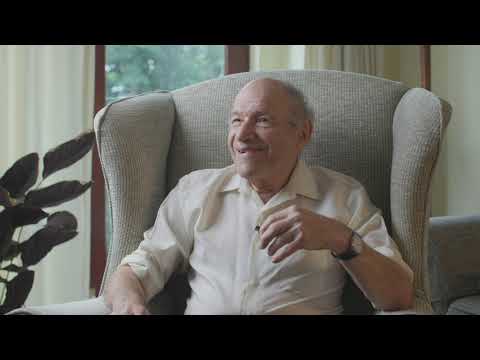LEO: the story of the world’s first business computer

Despite the large numbers of clerks employed today, sufficient clerks are still hard to find. With full employment, the security of clerical work does not offer the old attraction. Working on LEO, there was a buzz. You're doing something new and you're discovering
something every single day. Well, I went straight into being a programmer. But then there were only very few of us at that point. I mean, this was 1952. I was the first woman. To fulfil this modern need came LEO, the first automatic office in the world.
Electronic computers are not new but LEO was the first designed for office work. So exciting because you were in the forefront of technology. You were aware of everything new and progress and after the war and austerity, it was just brilliant. You are part of the development of today. Oh yes. One feels one's part of the world. Lyons was really quite an amazing organisation. It provided a range of facilities for people to
enjoy themselves. At the time in the ‘30s, ‘40s and ‘50s… ‘60s even, everybody knew Lyons and, if you lived in London, there were very few people who hadn’t, in one or way or another, experienced Lyons, eaten their cakes, gone to their restaurants, danced in their ballrooms. It really was an incredible organisation. It was huge, it had over 200 teashops for example. It had these very large hotels and corner houses… The Trocadero. It pervaded the country. There can be very, very few people who didn’t have a Lyons experience. Between nine and 10 football pitches. It was huge, and they did everything there from
make their products, their cakes, through to organising the delivery and so on. And they produced a huge amount of cakes, cupcakes, Swiss rolls, and a characteristic of that is the Swiss roll machine, which produced a continuous mile after mile of Swiss roll in their Cadby Hall factory. They were an ambitious company, but they knew that they had an army of people doing the clerical administration, and therefore automation was the answer. They'd applied some of it in terms of hand-cranked calculators and so on but they knew that they needed to take another step. LEO had key staff, for example, Simmons, Pinkerton and others that were very much into systems design and understood the business from a systems perspective. They were way ahead of their time. The people who went to America and saw computers recognised that the repetitive work in mathematics in a sense matched the repetitive work in accounting, and they saw that by using a computer they could not just repeat the jobs clerks had done, but do something more.
In fact, they don't get to see ENIAC, which is the big machine in America at that time. It's broken down. They come back quite disappointed, but they are directed towards a project at Cambridge University called EDSAC. And Lyons were very good at spotting the seeds of ideas. So a lot has to happen - EDSAC's not built, it's just an idea. So they decide it's worth pursuing and indeed they'll put about 3000 pounds,
invest into Cambridge University in partnership. They didn't know that it would work, but it nevertheless shows Lyons as a company that would invest in innovation and in risk. And they wanted to see what the answers to this experiment would be.
It works and they'll ring through to Lyons at Hammersmith and inform them that EDSAC has started to function. And it's very exciting because the Lyons board is meeting at that exact time. And on hearing the news, they'll press the button, if you like, to say let's move beyond the stage of preparation to the stage of delivery. And they'll start hiring people and bringing the resources together that are necessary to build something like EDSAC but this time at Cadby Hall. LEO people at the time thought that they could recruit all the people they want from inside the organisation.
So they did a kind of trawl and they designed a course for testing the aptitude of people. Well, first of all, we got selected, some of us, to go on what was known as a LEO Appreciation Course, where we spent a couple of days learning about how the computer worked and a very simple idea of how you could code it. About a dozen of us were chosen from amongst the various clerks, that included Frank Land who became one of my closest friends apart from anything else. I think we were the only two which were put forward for joining the LEO team. As I say, of which I knew nothing. We had to do homework and I was very lucky, I was able to use my wife to help me do the homework. Without that, I'm not sure where I would be today.
I found it a very tough course, but I enjoyed the course and it was challenging. I hadn't been challenged since I joined Lyons. The difference between LEO and EDSAC I think is made clear by the two names. EDSAC is an automatic calculator LEO is an electronic office, and those two names tell you everything about the difference between those two machines Huge cabinets, a raised platform under which were the mercury delay tubes, which stood about six foot tall, I suppose, and were in rows, and a huge great room.
I thought, well, that's what computers are like. I didn't question that. So, that was not the most remarkable feature for me. The most remarkable feature for me was what one could do with it rather than what it looked like. People saw computers really as almost magic machines. They called them electronic brains.
There was a report which used that term electronic brains and looked to electronic brains as providing the future. But the vast majority of people simply didn't know anything at all. And when you talked to people, they took you as some strange, esoteric being. When you said you were a programmer, they didn't know what that meant.
LEO is popularly known as an electronic brain. Its heart is a clock. The drumbeat of the machine. LEO takes its orders, or program, from code punched into paper tape or punched cards. It converts these into the language it understands, zeros and ones, or binary. Electronic valves are used as switches to add or subtract. Together, hundreds of valves perform complex calculations in fractions of a second. Everything is kept in check by LEO's own electronic brain, called the coordinator. LEO stores its instructions, or the
information the computer is working on, in memory. It uses an ingenious system of tubes filled with liquid mercury. Inside these mercury delay lines, the electronic zeros and ones are converted by a transducer into sound. Sound travels more slowly through mercury than the electrons in the circuit, temporarily delaying the information. LEO can store thousands of bits of information this way, looping them back through the tubes and only releasing them when the coordinator is ready for the next step. When LEO has finished its calculations, it prints out the results. Mr Thompson, first of all, what do you get out of the machine here, you're using it for payslips? In payroll yes.
And how many payslips can you get out of the machine per minute? Well, we can do about 40 in a minute at the moment. And that's one every...? One every one and a half seconds, approximately.
And how long would it take a normal clerk to work out the payslips? Well, with the help of traditional modern machinery in the office, it would take a minimum six minutes. It certainly is a brain to be envied. They looked at the tea shops and they found that the tea shop manageress was spending a vast amount of her time not looking after her customers, but deciding what stocks she should hold, what delivery she should get.
And these orders were telephoned into the Lyons office, into the catering office, and transcribed onto cards and entered into the computer. Once LEO was in operation and became known about, other people came to the Lyons management and asked can we use your computer? And this included, for example, the Met Office. It included the people who were building military aircraft and they came to us, can we do that? And we programmed that for him, and it became a regular weekly job in an entirely new way. For the Ordnance Board, LEO worked out range tables. For Handley Page, LEO carried out flutter and stress calculations for faster, safer flight. For Attwood Statistics, LEO analyses the findings of market research. For the coal board, LEO worked out the classifications in the fight against pneumoconiosis.
For the British Transport Commission, LEO worked out the shortest distance by rail from each station to all the other four thousand. This would have taken fifty clerks five years. For an hour a day, LEO belongs to its engineers for maintenance and testing. The voltage, normally kept to the operating figure, is made to fluctuate. Any valve or other component which can operate in such conditions … The pressure to keep it working was important. So we went round often tapping units to see if they would fail by tapping them. And that sometimes did occur. And of course, it was quite easy then if you tapped a particular
valve and something failed, then you knew that was the unit that was failing and so you would replace it. It had truly become a business computer that was reliable enough, powerful enough to sell, and therefore Lyons at that point are thinking, inevitably because it's the nature of that company, we can exploit this. Let's set up a LEO computer company and market this machine, because we're now confident enough that we could sell it to others and it will work. So LEO II is a more advanced version of LEO I in every respect, but particularly in terms of reliability. Working on LEO, there was a buzz. You're doing something new and you're discovering something every single day.
And we as junior programmers, as trainee programmers, would get together and discuss some of the things we’d done. And we'd say, you know, if you want to do this, do this, this and this, and it was one of continual excitement and considerable camaraderie. The courses took us to the can-can for a three course meal for three and six. - Someone on one of my courses I taught, had nothing but fish and chips every day, he wouldn't eat anything else. - Actually, we didn't all go off together because … - Yeah, it was brilliant. - We certainly enjoyed ourselves. It was a very young company, it was very forward thinking. I think it had always been forward thinking.
It was so exciting because most of our recruits were young graduates and Hartree House was on top of Whiteley's store in Queensway. And they had a big book department. So on sunny days, you could walk down Queensway and have lunch in Kensington Gardens. On rainy days, you'd meet all your friends in the book department of Whiteleys. It was like being at university, but with money. - And you could go and look at the clothes as well. - Oh yes, yes. And there was the Queen's ice skating rink. - It was a lovely part of the world.
- Yeah, so exciting because you were in the forefront of technology. You were aware of everything new and progress and after the war and austerity, it was just brilliant. I joined LEO in 1961 as a junior programmer, so everybody was fairly young. I was introduced to quite a few parties in those days. It was good fun, I was there only for actually nearly four years before I moved on,
having passed the aptitude test, which was an all day affair. And the aptitude test I remember was you were asked to describe how to make a cup of tea. And you had to sort of say that you needed a kettle and water and cups and tea. In those days it was leaf tea, I think, there weren't teabags. And it was interesting how some people actually failed to put the order in which you had to do things. - It was all logic. - It was logic.
So this was what was at the root really of the aptitude that a programmer needed. As a programmer, you were given a design for what is required. You then develop the program spec. You then draw a flowchart from the spec. And this flowchart could well be several pages long, and it's detailed of how you're going to write your program. Having done the flowcharts and had that agreed, you then write your
program and once you completed your program, you then desk check it. And once everybody's happy with that program, the program is then taken down to the punch room and punched on paper tape. You then run it on the computer. It's then taken down with a run sheet to the computer room. It's then run. And the following morning you get the results back and you can check the printout from the results to see whether it has actually worked in the way you were expecting it to work.
It's a very different world by the time we get to LEO III compared to LEO I. But it's the move to transistors that will greatly increase the speed and capacity of the computer that they offer. It was one of the most capable, and had this particular facility of being able to run a number of programs at the same time. This was one of the most important things, these programs didn't have to interfere with each other. And it was one of the first which implemented that in a working way. The management began to see that this could
be something we can sell and market and other people came to us, came to LEO, to say we want to see what your machine can do. We didn't have salesmen at that time. There were people called consultants. We advised these people on how they might operate. Sometimes we struck gold.
Sometimes people just dismissed us as so much fancy. Lyons' failure meant really that Lyons had to abandon LEO, the LEO company. It sold it to English Electric. It was called a merger, but in fact it was a takeover. Lyons at that time had a certain amount of financial problems,
and they felt that LEO was a drain on their resources. My guess is our team was sufficiently capable to build a world beater. But that's not how other people necessarily saw it. It's a historical if. The final date when LEO ceased to exist as operational machines was 1981. For me, the legacy of LEO is it's like a starting pistol. It started the notion that business could use a computer. What Lyons proved is that regardless of the size of your business, certainly true today, that you can make use of a computer.
Even a one man band today, if you're running a small business, you'd still use a computer in some shape, form or size. And I'd argue, that starts because of the work that Lyons did with LEO back in the 1950s. And a lot of that wouldn't have been there without people like Ray, Ernest Lenaerts, Pinkerton, Ernest Kaye. The early programmers like Mary Coombs, consultants like Frank Land. Who all were single minded, in terms of developing this technology and enabling businesses to get value out of it, not just selling them a piece of equipment.
I feel quite proud to have been part of it, actually. - I’m tremendously excited that I actually saw LEO I working. I taught computer science at AS level, and it was really interesting sort of teaching my own history. I remember taking in paper tape and showing them how to code it. There's one word that comes up regularly, and that's we were fond of our time at LEO.
It was just an exciting time. I feel proud. And as I've met more and more old timers, I'm even more proud looking at the achievement. Yes, I was very proud of working for Lyons, because it was so interesting and you really did feel that you were breaking limits that hadn't existed before. It was a great time. LEO developed this notion of a computer which is secure, which is reliable and which serves everyday users. But at the time, computers didn't provide that.
Something they can totally rely on. And that was so important for the work which LEO pioneered. But you're a pioneer.
2021-12-02 01:21


